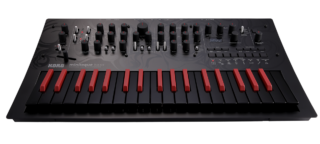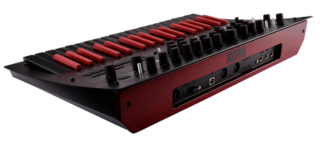Korg has introduced the Minilogue Bass, a style variation of the original Minilogue analog synthesizer.
The Minilogue Bass is essentially a limited edition alternate version of the original Minilogue. Physical differences include:
- An alternate black faceplate and black, designed to visually represent a swelling synth bass sound;
- The keyboard has black keys with red chromatic keys; and
- The red-colored wood rear panel.
The Minilogue Bass also comes with a new patch library, featuring 100 new sounds.
Audio Demos:
It’s unusual for Korg to market the Minilogue specifically as a bass synthesizer. Bass synths are generally monophonic and feature architectures tailored to creating bass sounds. The Minilogue is a polyphonic design that they’ve repurposed for this style variant, which means that the architecture was originally designed for all-around use.
Here’s what Korg has to say about the Minilogue Bass:
“Get juice and squelch. Throbbing Drive. Greasy fatness. Liquid ooze. And all in genuine analog warmth and studio quality clarity.
KORG’s minilogue – with its completely unique analog signal path, compact format, easy-to-play slim keys, and extensive sound capabilities – is one of the most popular, best selling synthesizers in music history.
Now welcome the incredible limited edition minilogue bass; designed and voiced to add inspirational bass into your music.
minilogue bass features programs created by a specially selected group of bass playing and programming pros from around the world so you get a big variety of rich, analog synth bass sounds that will inspire you and help your music stand out.”
The Korg Minilogue Bass
The Minilogue Bass includes two VCOs, a VCF, two EGs, a VCA and an LFO and features the unique wave shaping, introduced with the original Minilogue, for generating oscillator harmonics. It also features multiple ways to modulate the sound, including cross modulation, oscillator sync and a ring modulator. The high-pass filter features delay to expand the sonic possibilities.
Eight voice modes
The four-voice polyphonic structure and eight voice modes inherited from the minilogue make it less likely that each sound will get cut off when you play, and also create an even more robust sound when you stack voices. You can trigger various effects with the press of a button, such as UNISON (which produces thick bass and lead sounds), MONO (which adds a sub-oscillator that plays an octave lower and works great for bass), and DELAY that you can trigger while delaying the sound.
Voice modes include:
- POLY: works as a four-voice poly synth
- DUO: works as a poly synth with two voices stacked in unison
- UNISON: plays all voices in unison, as a mono synth
- MONO: operates as a mono synth with sub-oscillator
- CHORD: plays chords
- DELAY: voices 2–4 play in delayed sequence after voice 1 plays
- ARP: plays the arpeggiator (maximum of 4 voices)
- SIDE CHAIN: lowers the volume of the previously-played voice when a new voice is played
16-step sequencer
The minilogue bass features a 16-step polyphonic sequencer. The sequencer also includes motion sequence functionality, which memorizes the motions of up to four knobs or switches. With the sequencer, you can do real-time recording with overdub and step recording, and automatically play back repeated phrases while you use the keyboard to change the root position.
Oscilloscope for visualizing the sound
The built in OLED (Organic EL Display) features an oscilloscope function which displays sound as waveforms.
Pricing and Availability
The Korg Minilogue Bass is a ‘limited edition’, but the company has not provided any information on what that means. It’s priced at £649, with availability to be announced.






ridiculous.
Re-marketing. Gotta get rid of those spare synths/parts. Still, the Minilogue is an excellent synth. The keys do look sweet.
I’m holding out for the Minilogue Lead Synthesizer with ice white front panel designed to visually represent a wailing lead synth sound.
Really?!
What’s the point of that. Seems like all major synth manufacturers lost their plot…
yawn.
Hoping for all white or rainbow edition.
Perhaps with keyboard that will have different colour for every ridiculous mini keybed
Seriously though, it looks like we have reached stagnation point in hardware synth development.
Almost all Virtual representations of any synths from past are now available as plugins with indistinguishable sound for the fraction of the cost
Look, I get your point, and agree that this is just terrible, but there’s lots of interesting development going on…this synth ain’t the indicator. Maybe it’s the big companies that are the issue here.
funny joke……
https://www.synthtopia.com/content/2019/01/17/korg-kross-gets-new-color-options-edm-sounds/
Breathtakingly ugly
Disagree. Nice to see someone moving the status quo.
I’ve played harspichords with this color scheme. Thought it was quite tasteful and looked good. Definitely a matt finish on those though.
they had old microkorg limited edition keybeds lying around I guess.
come on, skip this junk and let’s get right to the eventide H90 announcement. now that’s cool.
Let me know when they release the Kylie Minilogue.
Nice one!
I could take or leave the black/red keys, but black panels always look better to me.
Companies keep coming back to black panels with high-contrast type for a reason – they’re easy to read in low light, which makes them better for stage use and for people (like me) that don’t have great vision.
I’m generally not an aesthetics-oriented type guy, but I owned a Sledge 2 (Black) for about a year. Other than the “Big Red Knobs”. the other thing you could see from across the studio were the smudged fingerprints on the black keys. At least it had normal-sized keys so you could clean them pretty easily. Never again will I buy a synth that has non-textured (shiny) black keys where the white keys usually are.
Of all the things you can use a Minilogue for, bass seems like bottom of the list. The filter on the Minilogue sucks all of the low-end out of the signal. I was hoping they tweaked the filter for this model, but it looks like it’s just a different paint job…?
Original classic minilogue excells in leads and pads imho but never bass …
… would have named it “Lead” loaded with ethereal pad and lead sounds and painted in cool white and blue.
I Like the “Classic” minilogue more then the “XD” Because:
Classic:
Filter sound and options very well suited for a polysynth.
Two full adsr envelopes with individual routing to filter and oscs.
XD:
Digital OSC and FX but everything else is lesser then the original.
Damn looks great. There are two kinds of people in the world….cool people who think red and black is the coolest combination of colors on Earth, and those lame people who disagree…which are you? ?
My favorite color/design are the vintage Yamaha CS5, CS10, CS15 and CS30 synthesizers.
If Korg is into making the most of existing hardware products, they really ought to look at their Electribes, which have been hacked to do different things. I love my blue Electribe, but can imagine it being more. Open up those boxes, Korg! Time for the Electibelogue!
Wait for the discount in a year and pick one up supa cheep!!!!
Yeah… Nah!
If they are going to re-issue synths, how about an updated MS-2000B? Or a re-issue of the SQ-10 and MS-50 modules to match the MS-20 Mini?
Never been fan of tribal design….
Sound demos on Korg website show this is a bass monster, good as any Moog or Sequential. So who is right? Has it been re-voiced? Did the original Minilogue have pre-filter delay? Hope I can manage to get one before they sell out, ‘cos at worst it’s no better than its original version, OR it could be the one everyone wants and can’t get!
They’ve rebadged it you fool!